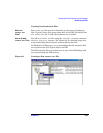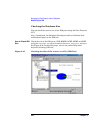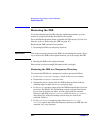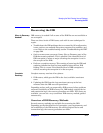
Managing the Data Protector Internal Database
Recovering the IDB
Chapter 9 417
Recovering the IDB
When Is Recovery
Needed?
IDB recovery is needed if all or some of the IDB files are not available or
are corrupted.
There are three levels of IDB issues, each with its own techniques for
repair:
• Troubleshoot the IDB problems that are caused by OS configuration
issues, such as not mounted filesystems, nameservice problems, and
so on. Refer to the troubleshooting section “Troubleshooting the IDB”
on page 592.
• Omit or remove non-core parts (binary files or filenames part) of the
IDB that contain problems. This is possible if the identified level of
IDB corruption is minor or major (meaning the corruption is not in
the core part of the IDB).
• Perform a complete recovery. This consists of restoring the IDB and
updating information that has been modified since the last IDB
backup. This is a must if the identified level of IDB corruption is
critical (meaning the corruption is in the core part).
Complete
Recovery
Complete recovery consists of two phases:
1. IDB restore, which gets the IDB to the last (available) consistent
state.
2. Updating the IDB from the last consistent state up to the last
moment when the IDB was still operational.
Depending on how well you prepared for IDB recovery before problems
occurred (availability of IDB recovery file, IDB backup, original device
and transaction logs), the recovery procedure can differ. If all these are
available, you can use a very convenient IDB recovery method, guided
autorecovery.
Overview of IDB Recovery Methods
Several recovery methods are available for recovering the IDB.
Depending on the identified level of corruption, your requirements, and
the availability of the IDB recovery file and the original device and
transaction logs, the recovery procedure can differ.


















